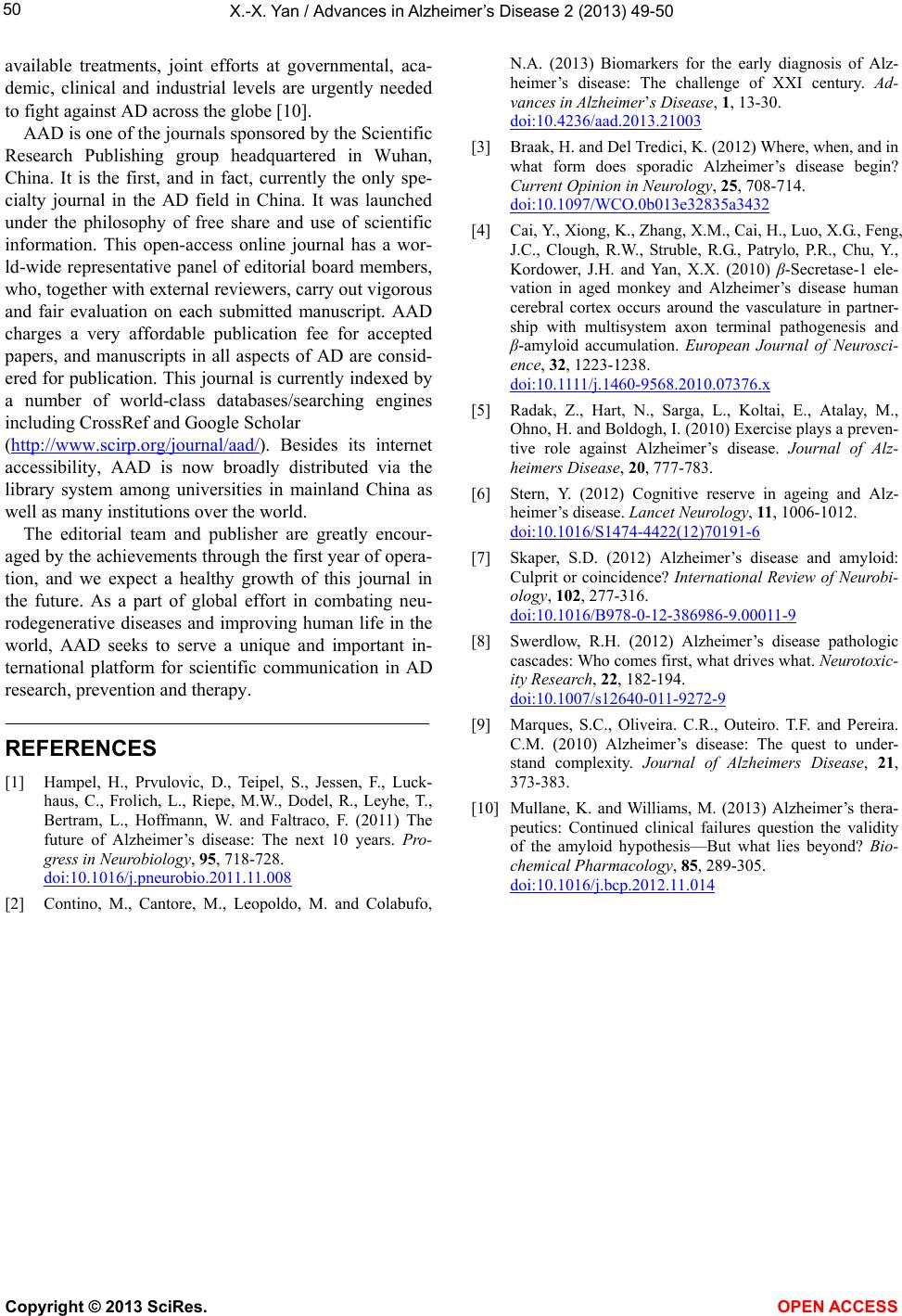
X.-X. Yan / Advances in Alzheimer’s Disease 2 (2013) 49-50
50
available treatments, joint efforts at governmental, aca-
demic, clinical and industrial levels are urgently needed
to fight against AD across the globe [10].
AAD is one of the journals spo nsored by the Scien tific
Research Publishing group headquartered in Wuhan,
China. It is the first, and in fact, currently the only spe-
cialty journal in the AD field in China. It was launched
under the philosophy of free share and use of scientific
information. This open-access online journal has a wor-
ld-wide representative panel of editorial board members,
who, together with external review er s, carry ou t v igoro us
and fair evaluation on each submitted manuscript. AAD
charges a very affordable publication fee for accepted
papers, and manuscripts in all aspects of AD are consid-
ered for publication. This journ al is currently indexed by
a number of world-class databases/searching engines
including CrossRef and Google Scholar
(http://www.scirp.org/journal/aad/). Besides its internet
accessibility, AAD is now broadly distributed via the
library system among universities in mainland China as
well as many institutions over the wo rld.
The editorial team and publisher are greatly encour-
aged by the achievements through the first year of opera-
tion, and we expect a healthy growth of this journal in
the future. As a part of global effort in combating neu-
rodegenerative diseases and improving human life in the
world, AAD seeks to serve a unique and important in-
ternational platform for scientific communication in AD
research, prevention and therapy.
REFERENCES
[1] Hampel, H., Prvulovic, D., Teipel, S., Jessen, F., Luck-
haus, C., Frolich, L., Riepe, M.W., Dodel, R., Leyhe, T.,
Bertram, L., Hoffmann, W. and Faltraco, F. (2011) The
future of Alzheimer’s disease: The next 10 years. Pro-
gress in Neurobiology, 95, 718-728.
doi:10.1016/j.pneurobio.2011.11.008
[2] Contino, M., Cantore, M., Leopoldo, M. and Colabufo,
N.A. (2013) Biomarkers for the early diagnosis of Alz-
heimer’s disease: The challenge of XXI century. Ad-
vances in Alzheimer’s Disease, 1, 13-30.
doi:10.4236/aad.2013.21003
[3] Braak, H. and Del Tredici, K. (2012) Where, when, and in
what form does sporadic Alzheimer’s disease begin?
Current Opinion in Neurology, 25, 708-714.
doi:10.1097/WCO.0b013e32835a3432
[4] Cai, Y., Xiong, K., Zhang, X.M., Ca i, H., Lu o, X.G., Feng,
J.C., Clough, R.W., Struble, R.G., Patrylo, P.R., Chu, Y.,
Kordower, J.H. and Yan, X.X. (2010) β-Secretase-1 ele-
vation in aged monkey and Alzheimer’s disease human
cerebral cortex occurs around the vasculature in partner-
ship with multisystem axon terminal pathogenesis and
β-amyloid accumulation. European Journal of Neurosci-
ence, 32, 1223-1238.
doi: 10 .1111 /j .1 460 -9568.2010.07376.x
[5] Radak, Z., Hart, N., Sarga, L., Koltai, E., Atalay, M.,
Ohno, H. and Boldogh, I. (2010) Exercise plays a preven-
tive role against Alzheimer’s disease. Journal of Alz-
heimers Disease, 20, 777-783.
[6] Stern, Y. (2012) Cognitive reserve in ageing and Alz-
heimer ’s disease. Lancet Neurology, 11, 1006-1012.
doi:10.1016/S1474-4422(12)70191-6
[7] Skaper, S.D. (2012) Alzheimer’s disease and amyloid:
Culprit or coincidence? International Review of Neurobi-
ology, 102, 277-316.
doi:10.1016/B978-0-12-386986-9.00011-9
[8] Swerdlow, R.H. (2012) Alzheimer’s disease pathologic
cascades: Who comes first, what drives what. Neurotoxic-
ity Research, 22, 182-194.
doi:10.1007/s12640-011-9272-9
[9] Marques, S.C., Oliveira. C.R., Outeiro. T.F. and Pereira.
C.M. (2010) Alzheimer’s disease: The quest to under-
stand complexity. Journal of Alzheimers Disease, 21,
373-383.
[10] Mullane, K. and Williams, M. (2013) Alzheimer’s thera-
peutics: Continued clinical failures question the validity
of the amyloid hypothesis—But what lies beyond? Bio-
chemical Pharmacology, 85, 289-305.
doi:10.1016/j.bcp.2012.11.014
Copyright © 2013 SciRes. OPEN A CCESS